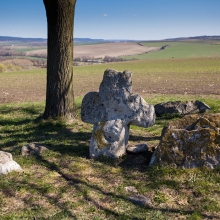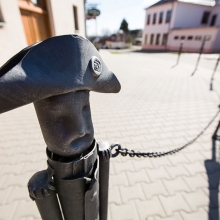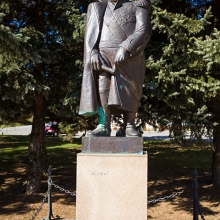On December 1st, a number of generals came to Křenovice. On the same day, local people were ordered to leave their houses immediately. All did so but a certain Jakub Fuchsa, who was hiding in a cellar and stayed there until the battle was over. When he got out he was in deep shock – he could see the Russians running towards Austerlitz (Slavkov) and Vážany. They did not even managed to pick up their knapsacks they had left behind in Křenovice before the battle. The local people, however, have not forgotten about them. The Russian “leather bags“ have completed their local clothes for many years after the battle was over.
Weyrother´s Plan Did not Impress Kutuzov at All
Austrian General Franz von Weyrother was responsible for the battle plan on the side of the Allied troops. The Russian command required him as a Chief of Staff[23] as he was well acquainted with the local territory. As early as on November 28th, Weyrother informed both Emperors on details of the plan during their stay in Vyškov. Now his task was to let the plan know to those who were supposed to lead the Allied troops. Since eight in the evening, officers were filling the room and Weyrother unfolded a detailed battlefield map. Then, with an extraordinary extent of self-confidence, he started to explain the details of his plan. After he finished, he had looked around his audience in a manner as a teacher when addressing his pupils. One of the generals put down a notice recalling his school years: “He was speaking so loud and with such a self-confidence proving his absolute dominance over us all, thus confirming our total incapability. He acted as a professor reading lecture to his students. Kutuzov, who had been sitting and drowsing in the corner before we came, went on snoring loud.“ In any case, Weyrother was unable to catch his listeners´ attention. And when Kutuzov came around, he admitted: “As far as I can see it, there is no other way but postpone the battle as much as possible. We have not got any news on Archduke and his army and the army positioning on the Heights is favourable for us.“ In spite of these comments, the proposal was adopted. Translations from German to Russian, however, had taken too much time and couriers were unable to deliver the instructions earlier than at six in the morning. Even more complicated was the instruction delivery to division commanders who received them as late as nine in the morning and some officers were delivered nothing at all – they only had to rely on their own experience and military flair.
Battle Plan Weaknesses
The plan revealed its weaknesses soon after the battle had started. Weyrother did not count on the fact the French would base their defence in the place called “Zlatý potok“ or that instead of faking their retreat they would start to attack. He also neglected another fact that the Russian army was not very flexible and thus unable to adjust its forces to frequent variabilities on the battlefield. Since the very beginning, Kutuzov, the Commander-in-Chief of the Russian army, had expressed strong doubts on the strategy, however, his proposals were rejected. This was another evidence of the fact that Kutuzov was deprived of the competent authority and it was some other people who took over final decisions, among them Weyrother, or the Emperor of Russia Tzar Alexander. To commemorate Kutuzov a monumet was erected on the square in Křenovice, in 2005. Apart from it, there is a memorable plate recalling the pre-battle meeting placed on the No. 65 House, the former Spáčil´s Farm. The farm is a private property and it still belongs to the Spáčil family. In Křenovice, there is also a church – Kostel sv. Vavřince (Church of St Lawrence) - the place where Russian captives were held. You will certainly observe a special type of railing with motives of Napoleonic soldiers placed on the square curve not far from the confectionery´s and the local inn.
“Zlatá hora“ at Present and Past Times
Zlatá hora (The Golden Mountain) is towering above the village of Křenovice. When you reach its top you will observe a stone-made cross of conciliation - due to tradition, it comes from the period of Great Moravia. There is also a mass grave where hundreds of soldiers, who lost their lives in the battle, rest in peace. Local people call it “Na krchůvku.“ The unusual Czech word “krchůvek,“ denoting old cemeteries, has been used to name some other similar places within the Czech Republic, too.
Every year, on Friday, on the eve of the Battle, local people of Křenovice organize gatherings of soldiers at campfires. You may find not only military fans in French and Austrian uniforms there but also military cooks, carriages and the so called vivandières or cantinières (the Czech version “markytánky“ is a corruption of the German word – Marktfrau). It was common for cantinières to provide food and drink in field canteens and each of them had her “husband“ in regiment or in batallion whose position was respected and they provided the women with protection. The women often followed soldiers in battlefields and they nursed the wounded there. The event provides visitors also with military clash shows and it is completed by a march of uniformed soldiers with lanterns towards the mountain Zlatá hora.
“Staré vinohrady“
and Its Battle Clatter
You should not omit visiting the place called “Staré vinohrady“ either. It is a place General Kutuzov had chosen for his headquarters. At eight in the morning, accompanied by the Emperor Francis and Tzar Alexander, he was watching the French soldiers´ advancement and his own soldiers´ descent. The place Staré vinohrady is available to be “conquerred“ as it was done by the French in the past. You should be on alert though, as it will not be that easy. Today, the hill is in the middle of fields and the access is not very easy, however from historic point of view the place is of the utmost interest of all battlefields concerned. There are good chances for you to discover a number of other reminders that have been scattered all over the place. There is a Column of the Crucifixion south-east of the top, on the crossroads from Prace to Křenovice and from Blažovice (Balzowitz) to Zbýšov (Zbeichow). Surrounded by a slightly undulating terrain, so typical for South Moravia, it is an ideal place to take a photo or two. Off southwards near the road, you will come across a monument devoted to the Three Emperors. It is composed of three stone columns recalling the Three Emperors and on its top there is a symbol of the Battle – the Sun. The monument has been erected on the place where all of them – the Russian Tzar Alexander, the Emperor of Austria Francis and the Emperor of France Napoleon – were passing by at different times of the day - December 2nd, 1805.
 Křenovická válečná porada.jpg)








